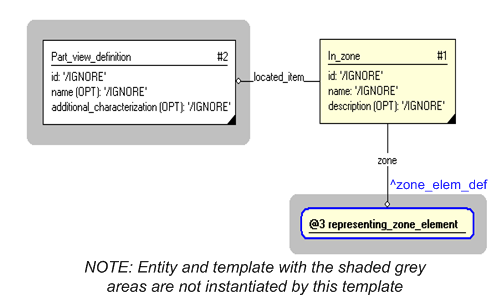| Template:— assigning_zone (asg_zone) |
Date: 2008/03/05 16:17:55
Revision: 1.3
|
This section specifies the template assigning_zone.
NOTE
An explanation of a template and the associated instantiation path is
provided in the
Template overview
section.
This template describes how to represent an association the between an item and a the zone its in.
The EXPRESS-G diagram in
Figure
1
shows the templates and EXPRESS entities that are required
to represent the template
"assigning_zone".
The text highlighted in blue shows the template parameters.
Figure 1 — An EXPRESS-G representation of the Information model for assigning_zone
The graphic for the template to be used in other EXPRESS-G diagrams
is shown in Figure
2
below.
Figure 2 — The graphical representation of the assigning_zone template
The following input parameters are defined for this template:
The entity which relates to the @zone.
The following reference parameters are defined for this template:
Allow the
In_zone
entity instantiated in this path to be referenced when this template is used.
Note: The
In_zone
entity can be referenced in a template path by:
%^target = $assigning_zone.in_zone%
where
target
is the parameter to which the
In_zone
is bound.
The instantiation path shown below specifies the entities that are to be
instantiated by the template.
A description of templates and the syntax for the instantiation path is
provided in the
Templates Help/Information section.
In_zone-- Mark the In_zone entity as -- referable when this template is used by binding it to the reference -- parameter ^in_zone %^in_zone =
In_zone%
^in_zone.id = '/IGNORE'
^in_zone.name = '/IGNORE'
^in_zone.description = '/IGNORE'
^in_zone.located_item ->
@item
^in_zone.zone ->
@zone
The following entities are instantiated with attributes as specified:
The instance diagram in Figure
3
shows an example of the EXPRESS entities and templates that are instantiated by the template:
/assigning_zone(item='#2', zone='#48')/
(an illustration of the consolidated assigning_zone template is shown in
Figure
4 below.)
Figure 3 — Entities instantiated by assigning_zone template
The instance model in STEP ASCII exchange file format (ISO 10303 Part
21 syntax) is:
#2 = PART_VIEW_DEFINITION('/IGNORE','/IGNORE','/IGNORE',#3,(),#4);
#1 = IN_ZONE('/IGNORE','/IGNORE','/IGNORE',#2,#48);
#48 = ZONE_ELEMENT_DEFINITION('/IGNORE','/IGNORE','/IGNORE',#49,(),#26);
The instance diagram in
Figure
4
shows the graphic symbol for the template that is to be
used in other instance diagrams. The example template is:
/assigning_zone(item='#2', zone='#48')/
Figure 4 — Instantiation of assigning_zone template
Characterizations
No common characterizations of the template
assigning_zone
have been identified. However, the ISO 10303-239 EXPRESS model
may enable other assignments to the entities instantiated by the template.




